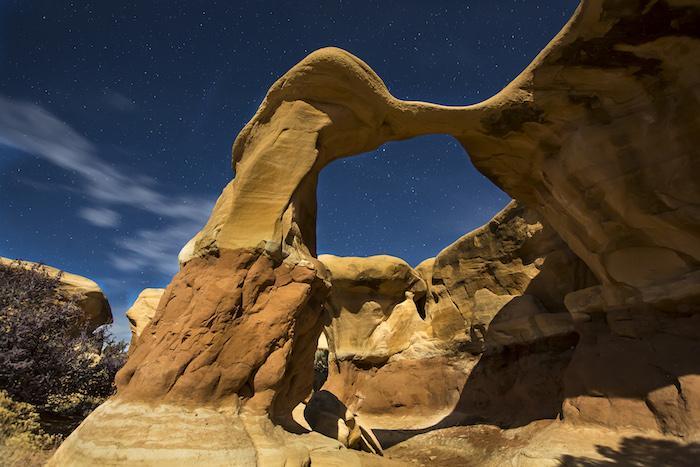
President Trump is expected to visit Utah on Monday to announce plans to shrink the size of Bears Ears National Monument and Grand Staircase-Escalante National Monument/Metate Arch in Grand Staircase-Escalante by BLM
Editor's note: This corrects that the survey was paid for by the American Monument Alliance, not the Conservation Alliance.
With President Trump planning to visit Utah on Monday to announce his decision to shrink the size of two national monuments in the state, rallies and surveys were at work to raise public opposition to the president's action.
"The president is capping his celebration of Native American Heritage Month by opening the door to new drilling and mining on land considered sacred by tribal nations," said Jennifer Rokala, executive director of the Center for Western Priorities. "After his appalling remarks at the White House on Monday, President Trump’s assault on tribal interests continues at a staggering pace."
During a stop in Utah the president is expected to say he is reducing in size both Bears Ears National Monument, which President Obama designated a year ago, and Grand Staircase-Escalante National Monument, which President Clinton designated in 1996. The two monuments harbor rich archaeological and paleontological resources in a rough and wild landscape.
U.S. Sen. Orrin Hatch, a Utah Republican, lobbied the president to at least shrink the two monuments. Back in October the senator said Grand Staircase-Escalante National Monument would be reduced in size at least enough to allow coal mining on the Kaiparowits Plateau. Coal companies were poised to dig into the plateau in 1996, when President Clinton stopped that possibility by designating the monument.
According to The Salt Lake Tribune, which reported Tuesday on the president's upcoming visit to Utah, tribes were planning to sue him over his anticipated decision.
"The tribes view this as an affront to themselves and their own self determination,” Natalie Landreth, senior staff attorney for the Native American Rights Fund, told the newspaper. “All of us, all five tribes will be suing jointly the day he makes an announcement.”
Word of President Trump's impending visit came as a new poll came out claiming that nearly half of voters don't want the president to alter any national monument, while 42 percent would like to see new monuments created.
"...71 percent oppose removing the protected status of some national monuments if it would reduce the size of the monument’s public land and increase corporate development on this land," said a release from pollster McLaughlin & Associates. "Only 22 percent would support this, while 8% percent are unsure."
While the pollster initially said the survey was paid for by the Conservation Alliance, on Wednesday they corrected that to the American Monument Alliance. They could not specifically say who was on the alliance.
Meanwhile, the Southern Utah Wilderness Alliance was organizing a rally in support of national monuments for Saturday.
"Join fellow Utahns on December 2nd to resist Trump’s efforts to dismantle our national monuments," the advocacy group said in a message on its website. "Let’s send a clear and visible message that we intend to 'Honor Tribes' and defend the priceless scientific, cultural, and ecological legacy these monuments represent."
As of mid-day Tuesday, more than 2,000 people had indicated on a Facebook page that they planned to attend the rally at the state Capitol.

It's believed that President Trump will greatly reduce the size of Bears Ears National Monument/BLM, Bob Wick
Whether President Trump has the authority to reduce the size of a national monument has been debated and likely will be the focus of legal challenges expected in the wake of his announcement. Past presidents have reduced the size of several national monuments, according to National Park Service records.
* President Eisenhower reduced the reservation for Great Sand Dunes National Monument by 25 percent. (He reduced the original 35,528-acre monument by a net 8,920 acres.)
* President Truman diminished the reservation for Santa Rosa Island National Monument by almost half. (The original 9,500-acre reservation by Franklin Roosevelt was diminished by 4,700 acres.)
* Presidents Taft, Wilson, and Coolidge collectively reduced the reservation for Mount Olympus by almost half, the largest by President Wilson in 1915 (cutting 313,280 acres from the original 639,200-acre monument).
* The largest percentage reduction was by President Taft in 1912 to his own prior reservation in 1909 for Navajo National Monument. (His elimination of 320 acres from the original 360-acre reservation was an 89 percent reduction.)
The Grand Staircase-Escalante monument is 1.9 million acres in size, and has proved to hold a treasure trove of paleontological wonders. Bears Ears National Monument, at roughly 1.3 million acres, contains archaeological wonders from long ago civilizations and parts of it are considered sacred by Native Americans.
It was not immediately known whether Interior Secretary Ryan Zinke, who recommended that the two monuments be shrunk, would accompany the president to Utah. The secretary also called for changes to some other monuments pertaining to acceptable practices, such as logging and commercial fishing.
President Trump early this year directed Secretary Zinke to review 27 national monuments, designated as long ago as 1996, to determine whether their designations had been properly made under The Antiquities Act. Secretary Zinke completed his review in late August, having visited just eight of the 27, but didn't make his recommendations public. Several organizations have sued the secretary for not making his recommendations, and the process he followed to reach them, public.






Add comment